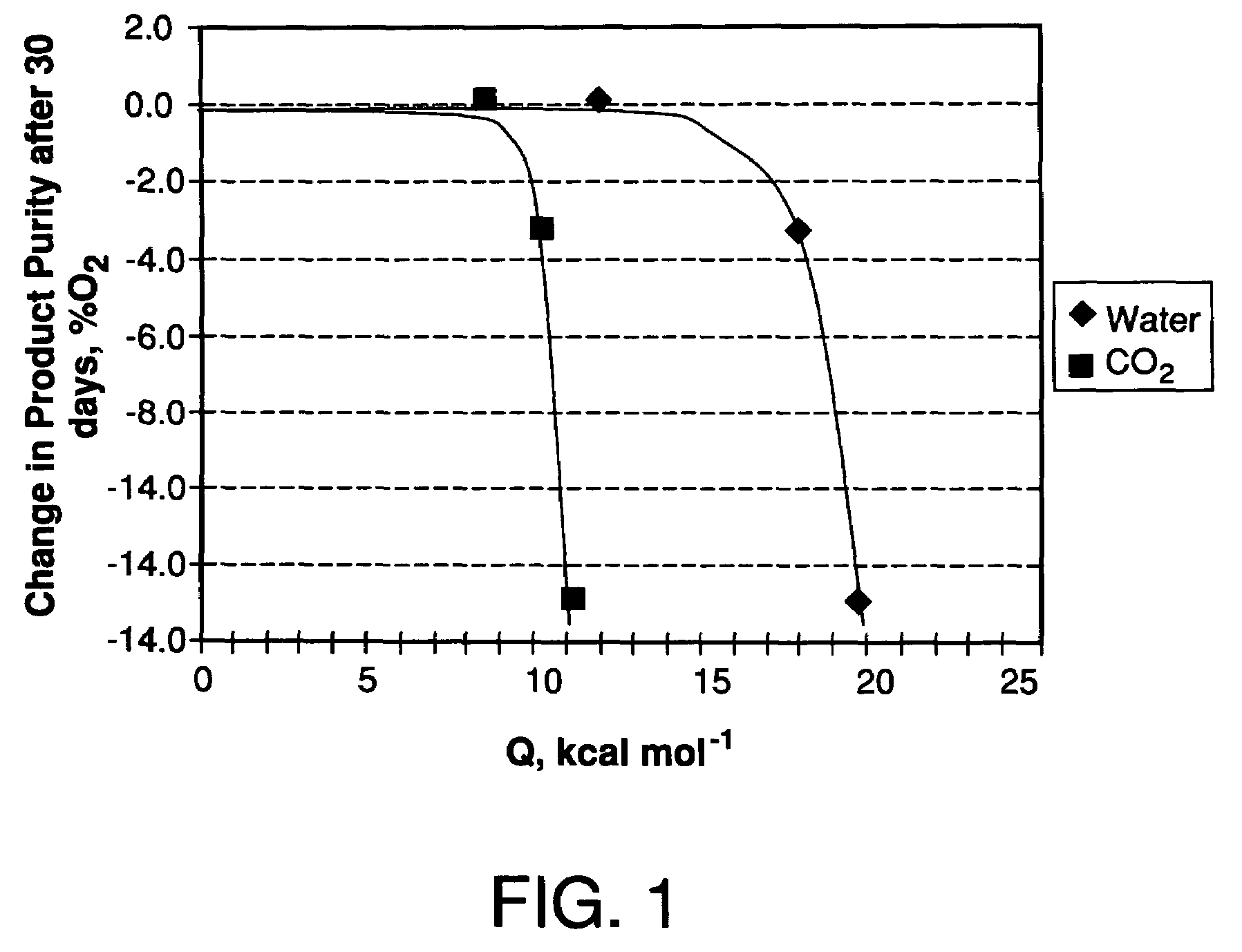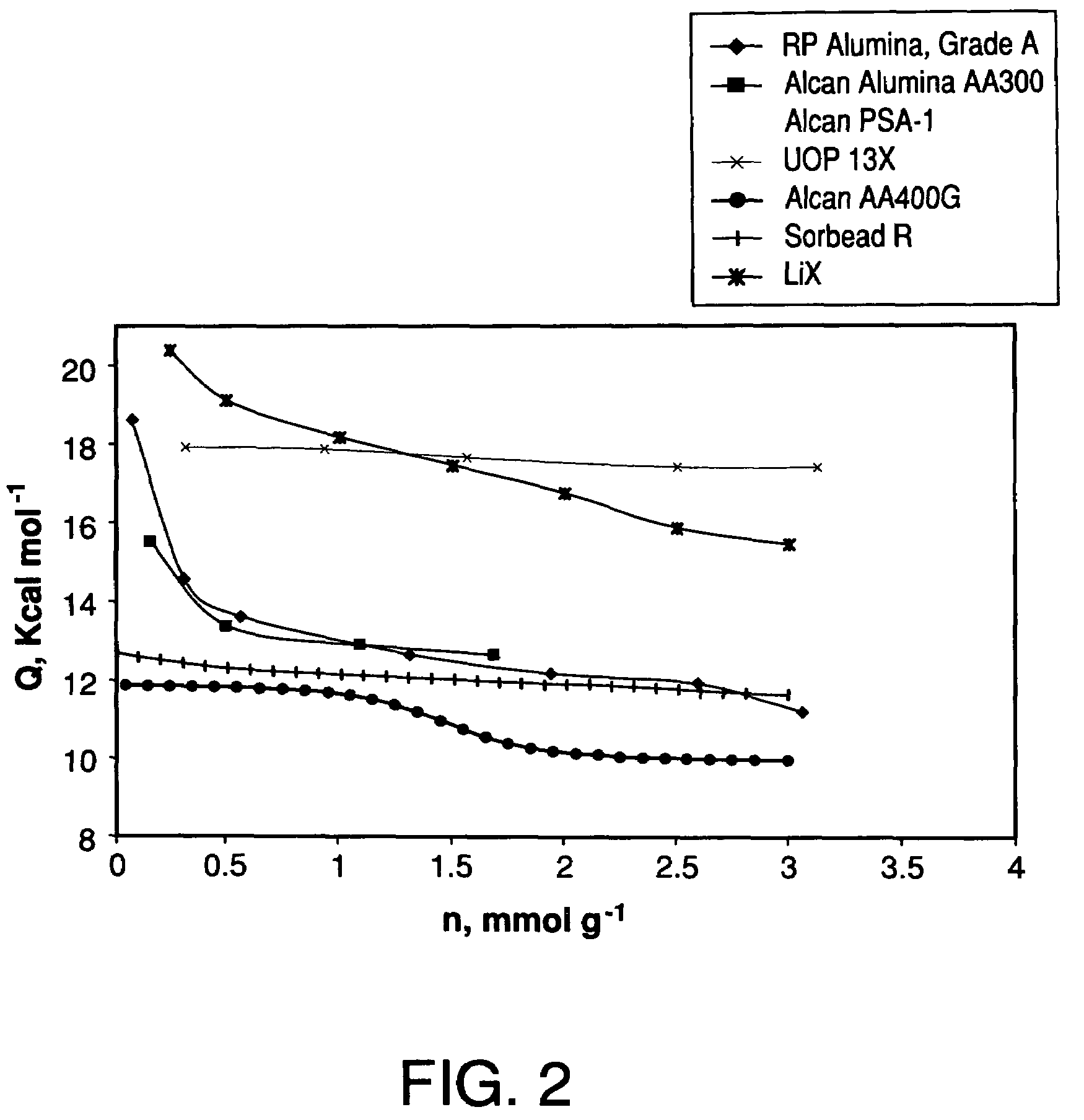Performance stability in rapid cycle pressure swing adsorption systems
a technology of rapid cycle pressure swing and adsorption system, which is applied in the direction of oxygen/ozone/oxide/hydroxide, respirator, and separation process, etc., can solve the problems of increasing the cost and weight of the oxygen concentrator system, affecting the performance of small psa air separation system, and especially serious impa
- Summary
- Abstract
- Description
- Claims
- Application Information
AI Technical Summary
Benefits of technology
Problems solved by technology
Method used
Image
Examples
example 1
[0024]A large single-bed PVSA system with a bed diameter of 30 inches (2 / r=0.052 cm−1) and a bed depth of 4 feet, 7% of which is a pretreatment layer of NaX zeolite and the remainder of which is a main adsorbent layer of 88% Li-exchanged Li LSX, was operated to recover oxygen from air using a simple four step cycle: feed / make product, evacuation, purge, and feed repressurization. The total cycle time may range from 30-40 seconds depending on the product requirements. The superficial velocity of untreated feed gas was 2.5 ft / sec, the total bed superficial contact time was 1.58 sec, and the pretreatment layer superficial contact time was 0.11 sec. The system was operated at a nearly constant production rate of 500 slpm at 88 volume % oxygen purity for 30 days and showed no decline in performance based on the product purity over this operating period.
example 2
[0025]The PVSA system described in Example 1 was scaled down to a small bench-top single bed system with an adsorbent vessel inside diameter of 0.9 inches (2 / r=1.75 cm−1) and was operated using the same process cycle of Example 1 but at production rates between 22 and 50 standard cm3 per minute. Experiments were run using a highly lithium-exchanged (i.e., lithium exchange above 88%) low-silica X-type zeolite (LiLSX) without a pretreatment layer, an 88% lithium exchanged low-silica X-type zeolite (LiLSX) without a pretreatment layer, and a highly lithium exchanged LiLSX layer with a NaX pretreatment layer having 30% and 40% of the total bed depth. Decreases in the product purity over time at a constant rate of production were unexpectedly observed in each of these experiments as shown in the results of Table 2. Subsequent analyses of the beds after the experiments were ended indicated that water and carbon dioxide had contaminated the LiLSX zeolite, thereby affecting oxygen recovery ...
example 3
[0027]The NaX pretreatment layer of Example 2 was replaced by activated alumina layers having 10% to 30% of the total adsorbent bed depth. The same system and cycle of Example 2 were used to evaluate the operating performance of the activated alumina pretreatment layers and the results are given in Table 3.
[0028]The best performance of the small-bed PVSA system of Examples 2 and 3 was observed using Alcan alumina AA400G for the pretreatment adsorbent at 25% of the bed depth and using the highly-exchanged LiLSX as the main adsorbent layer. At similar contact times and superficial velocities, this performance showed no appreciable decline in product purity over time at a constant production rate. In all cases, the use of activated alumina as the pretreatment adsorbent showed significantly lower deactivation rates compared with the use of NaX as the pretreatment adsorbent. This is unexpected because NaX has a significantly higher affinity for water as seen in Table 1, and also because ...
PUM
| Property | Measurement | Unit |
|---|---|---|
| contact time | aaaaa | aaaaa |
| particle diameter | aaaaa | aaaaa |
| particle diameter | aaaaa | aaaaa |
Abstract
Description
Claims
Application Information
 Login to View More
Login to View More - R&D
- Intellectual Property
- Life Sciences
- Materials
- Tech Scout
- Unparalleled Data Quality
- Higher Quality Content
- 60% Fewer Hallucinations
Browse by: Latest US Patents, China's latest patents, Technical Efficacy Thesaurus, Application Domain, Technology Topic, Popular Technical Reports.
© 2025 PatSnap. All rights reserved.Legal|Privacy policy|Modern Slavery Act Transparency Statement|Sitemap|About US| Contact US: help@patsnap.com



